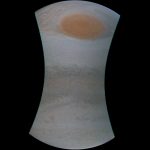Jupiter’s Stormy North0
- From Around the Web, Space
- January 27, 2018
See Jupiter’s northern polar belt region in this new view taken by NASA’s Juno spacecraft.

See Jupiter’s northern polar belt region in this new view taken by NASA’s Juno spacecraft.

NASA has released beautiful new images of Jupiter’s turbulent atmosphere from the tenth close flyby of its Juno spacecraft.

Researchers hope Juno could help shed light on why Jupiter’s northern and southern lights behave differently.

NASA is putting up the raw images of Jupiter’s red spot straight from the Juno Spacecraft.

NASA’s Juno mission completed a close flyby of Jupiter and its Great Red Spot on July 10, during its sixth science orbit.

Jupiter may have been a very early bloomer, gaining significant mass within the first million years of the solar system’s birth, according to a new analysis of meteorite fragments.

Forget everything you knew about gas giants, because based on the latest results from the Juno mission, we were wrong. We were so wrong.

Early science results from NASA’s Juno mission to Jupiter portray the largest planet in our solar system as a complex, gigantic, turbulent world, with Earth-sized polar cyclones, plunging storm systems that travel deep into the heart of the gas giant, and a mammoth, lumpy magnetic field that may indicate it was generated closer to the planet’s surface than previously thought.

Here are eight surprising things NASA has learned so far.

NASA’s Juno spacecraft entered safe mode Tuesday, Oct. 18 at about 10:47 p.m. PDT (Oct. 19 at 1:47 a.m. EDT). Early indications are a software performance monitor induced a reboot of the spacecraft’s onboard computer.